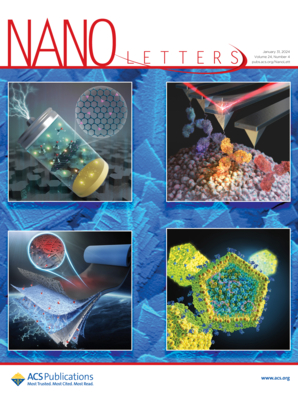Long-Term Single-Particle Tracking of Membrane Proteins Enabled by Upconversion Alkaline-Earth Nanoprobes.
IF 9.1
1区 材料科学
Q1 CHEMISTRY, MULTIDISCIPLINARY
引用次数: 0
Abstract
Single-particle tracking (SPT) provides mechanistic insights into individual biomolecules but suffers from the limited photostability of conventional probes. Upconversion SPT (uSPT), employing lanthanide-doped nanoparticles (UCNPs) as probes, enables extended imaging durations; however, its broader application is hindered by the trade-off between nanoparticle size and brightness. To overcome this limitation, we designed ∼10 nm core-shell-shell UCNPs incorporating strontium-based alkaline-earth materials, achieving both compact dimensions and enhanced luminescence. These engineered UCNPs exhibit a 4.6-fold increase in brightness compared to that of conventional sodium-based counterparts. Using these probes, we tracked epidermal growth factor receptor (EGFR) dynamics and identified four distinct motion states (immobile, confined, free, and directed) highlighting the motional heterogeneity and reversible transitions of individual EGFR. Treatment with latrunculin A markedly altered these motional states, underscoring the critical role of the cytoskeleton in regulating EGFR dynamics. Collectively, our findings demonstrate the utility of uSPT for probing membrane protein behavior and dissecting complex cellular processes.上转换碱土纳米探针实现膜蛋白的长期单粒子跟踪。
单粒子跟踪(SPT)提供了对单个生物分子的机理见解,但传统探针的光稳定性有限。上转换SPT (uSPT),采用镧掺杂纳米粒子(UCNPs)作为探针,可以延长成像时间;然而,它的广泛应用受到纳米颗粒尺寸和亮度之间权衡的阻碍。为了克服这一限制,我们设计了含有锶基碱土材料的~ 10纳米核-壳-壳UCNPs,实现了紧凑的尺寸和增强的发光。与传统的钠基纳米粒子相比,这些工程纳米粒子的亮度增加了4.6倍。使用这些探针,我们追踪了表皮生长因子受体(EGFR)的动态,并确定了四种不同的运动状态(固定、受限、自由和定向),强调了个体EGFR的运动异质性和可逆转变。用拉runculin A治疗显著改变了这些情绪状态,强调了细胞骨架在调节EGFR动力学中的关键作用。总的来说,我们的发现证明了uSPT在探测膜蛋白行为和解剖复杂细胞过程中的效用。
本文章由计算机程序翻译,如有差异,请以英文原文为准。
求助全文
约1分钟内获得全文
求助全文
来源期刊

Nano Letters
工程技术-材料科学:综合
CiteScore
16.80
自引率
2.80%
发文量
1182
审稿时长
1.4 months
期刊介绍:
Nano Letters serves as a dynamic platform for promptly disseminating original results in fundamental, applied, and emerging research across all facets of nanoscience and nanotechnology. A pivotal criterion for inclusion within Nano Letters is the convergence of at least two different areas or disciplines, ensuring a rich interdisciplinary scope. The journal is dedicated to fostering exploration in diverse areas, including:
- Experimental and theoretical findings on physical, chemical, and biological phenomena at the nanoscale
- Synthesis, characterization, and processing of organic, inorganic, polymer, and hybrid nanomaterials through physical, chemical, and biological methodologies
- Modeling and simulation of synthetic, assembly, and interaction processes
- Realization of integrated nanostructures and nano-engineered devices exhibiting advanced performance
- Applications of nanoscale materials in living and environmental systems
Nano Letters is committed to advancing and showcasing groundbreaking research that intersects various domains, fostering innovation and collaboration in the ever-evolving field of nanoscience and nanotechnology.
 求助内容:
求助内容: 应助结果提醒方式:
应助结果提醒方式:


